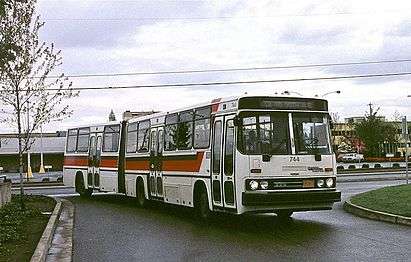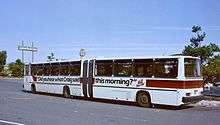Crown-Ikarus 286
| Crown-Ikarus 286 | |
|---|---|
 TriMet #744, a 1982 Crown-Ikarus 286 in Portland, Oregon (1993 photograph) | |
| Overview | |
| Type | transit bus |
| Manufacturer |
Ikarus Body and Coach Works Crown Coach Corporation |
| Production | 1980-1986 |
| Assembly |
Budapest, Hungary (initial assembly) Final Assembly: Los Angeles, California (final completion) |
| Body and chassis | |
| Body style | articulated bus |
| Layout | Mid-mounted engine/"puller" (6x2) |
| Doors |
Two Three |
| Floor type | High floor |
| Chassis | semi self-supporting with subframe |
| Related | Orion-Ikarus 286/Orion III |
| Powertrain | |
| Engine | Cummins 855 cu in (14 L) NHHTC inline-6 |
| Transmission |
4-speed Allison HT740 automatic Voith D864.2 automatic |
| Dimensions | |
| Length |
55 ft (17 m; 660 in) 60 ft (18 m; 720 in) |
The Crown-Ikarus 286 is a type of transit bus that was manufactured for the U.S. market from 1980 until 1986, under a joint venture between the Ikarus Body and Coach Works (Ikarus), of Budapest, Hungary, and Crown Coach Corporation from Los Angeles, California in the United States. Loosely based on the Ikarus 280, the Crown-Ikarus 286 is a high-floor articulated bus. Due to their use in the United States, the Crown-Ikarus buses were the first buses equipped with a wheelchair lift that were produced by Ikarus.[1]
After a number of production problems arose,[2] the Crown-Ikarus 286 was withdrawn from the market in 1986, following the collapse of the joint venture.[3][4] A total of 243 examples were produced for nine different operators.
Background
In the late 1970s, the era of the "fishbowl" mass-transit buses in the United States and Canada was coming to a close; GM and Flxible ended US production of their "New Look" buses in 1977 and 1978, respectively. To gain a share in building the next generation of mass-transit buses, many manufacturers commenced design work for new vehicles. To diversify its business beyond the fragile school bus industry of the late 1970s, California-based Crown Coach sought to enter the mass-transit market. While its chief competitor Gillig Corporation began design work on what would become the Gillig Phantom, Crown Coach did not have the resources on its own to develop its own design from the ground up.
In 1979, the company developed a partnership with Hungarian bus manufacturer Ikarus Body and Coach Works. With an annual production of 13,000 transit vehicles (triple the combined output of all US transit manufacturers), Ikarus was one of the largest bus manufacturers in the world.[1][2] In addition to Crown Coach gaining entry into the mass-transit segment, the partnership allowed Hungary to obtain much-desired hard currency and eased a trade imbalance between Eastern Europe and the West.[2]
By partnering with Crown Coach (a company known for building vehicles with a 20-year lifespan), the final assembly would be completed in the United States to much more stringent American standards. Final assembly in California allowed the interiors and features of the vehicles to be customized to the needs of American end-users, such as the inclusion of wheelchair lifts for passengers with disabilities.[2] Sales contracts of the vehicles were managed by Crown Coach, so as to make it easier to ensure that the work satisfied U.S. federal "Buy America" requirements[2] (). All buses manufactured under the Crown-Ikarus name were considered model 286, although different orders carried a seldom-noted numerical suffix, for example Portland's being model 286.02.
Production History

The first order for the Crown-Ikarus was placed in November 1979.[5] In its Budapest factory, Ikarus produced the body shells of its Ikarus 280 articulated transit bus modified for the North American market; the largest modification was the width of the bodyshell, from 98.4 in (2,500 mm) to the 102 in (2,591 mm) body width seen in North American transit buses. After shipment to Crown Coach in Los Angeles, the fabricated body shells were fitted with engines, transmissions, brakes, and destination signs, among other items.[1] For the first vehicles, the engines and transmissions were shipped to Hungary for installation, but subsequent examples saw the entire powertrain fitted at the Crown Coach factory.[5]
The Crown-Ikarus 286 was sold in 55-feet and 60-feet configurations with two or three doors. With the exception of the Houston METRO vehicles (five were fitted with 61 forward-facing seats), all vehicles were fitted with transit-style seats. In a 60-foot configuration, the passenger capacity was 73.[3]
Shared with the Crown Supercoach line, the 286 was fitted with a 350 hp Cummins NHHTC underfloor diesel. Most vehicles were fitted with an Allison HT740 automatic transmission, while a Voith D864.2 automatic transmission was fitted for several vehicles operated in Houston and in Milwaukee.[5] The axles were also U.S.-made.[6] In the mid- to late 1980s, Tri-Met replaced the Cummins engines in its Crown-Ikarus buses with Detroit Diesel DDA 6-71 engines (also used in Crown Coach school buses), in an effort to improve reliability and reduce maintenance costs.[7]
Ikarus also hoped to sell a trolleybus version of the 286 in North America through Crown Coach.[8] With this in mind, an Ikarus 280T3 articulated trolleybus was transported to North America, and was demonstrated on the Mexico City[9] San Francisco,[10] and Seattle trolleybus systems.[11] from 1981 to 1982. Ultimately, no orders were received, and Crown Coach did not build any trolleybuses.
Post-production issues
Various problems were experienced with the completed buses during their use, including doors malfunctioning and windows coming out.[2] In Portland, Oregon, which had more Crown-Ikarus buses than any other transit system, owner Tri-Met found that its 87 buses needed numerous repairs and modifications, to fix what it considered to be significant defects.[12][13] The agency worked with the manufacturer to correct many of them, but carried out some of the repairs and modifications itself, sometimes at its own expense.[14] In 1985, when the buses involved were three to four years old, Tri-Met filed a lawsuit against the manufacturers, alleging breach of contract.[12] The suit identified 45 separate defects, including frame cracks, and charged that Crown Coach and Ikarus had been unable or unwilling to correct all of them.[12][13] Tri-Met officials said the problems and frequent breakdowns of the buses led to there being days when only about 50 of the 87 buses were operational.[13] According to Tri-Met, the issue was compounded by maintenance diagrams that were "written mostly in Hungarian".[13] The lawsuit was later postponed, as the parties hoped to settle their differences out of court,[15] and 17 months after the suit was filed, Tri-Met announced that a settlement had been reached.[14] The warranties on Tri-Met's buses, which had originally been for one to two years but been extended,[12] were now extended through 1992, but most other details of the 1987 settlement were not released publicly.[14]
By 1986, Crown Coach had already ceased taking orders for the Crown-Ikarus 286, and production under the joint venture ended.[3] Ikarus re-entered the U.S. market on its own in 1989 as Ikarus USA, which after a series of reorganizations became North American Bus Industries (NABI) in 1996.
Operators
Crown-Ikarus buses were sold new to a total of only nine transit systems, all located in the United States.
| Operator | Location | Quantity | Notes |
|---|---|---|---|
| TARC | Louisville, Kentucky | 15 | Delivered in 1980, first Crown-Ikarus 286 buses sold.[3][5] |
| TriMet | Portland, Oregon | 87 | Delivered from 1981 to mid-1982; the largest order of the 286
All had three doors; the rear door was fitted with a wheelchair lift. |
| Houston METRO | Houston, Texas | 50 | Five fitted with forward-facing 61 "suburban" seats |
| MCTS | Milwaukee, Wisconsin | 40 | Purchased in 1984, retired in 2000 |
| SamTrans | San Mateo County, California | 10 | |
| Capital District Transportation Authority | Albany, New York | 8 | |
| Santa Clara County Transportation Agency | San Jose, California | 15 | To AC Transit in 1988 |
| TheBus | Honolulu, Hawaii | 8 | |
| Jacksonville Transportation Authority (JTA) | Jacksonville, Florida | 10[3] | |
| AC Transit | Oakland, California | N/A | Leased 15 buses from Santa Clara County from 1988.[16] |
See also
- Ontario Bus Industries, which produced similar Ikarus buses in Canada from 1986 to 1989 known as the Orion-Ikarus 286.
References
- 1 2 3 Bushell, Chris; and Stonham, Peter (eds.) (1986). Jane's Urban Transport Systems 1986, pp. 484–486. London: Jane's Publishing Company. ISBN 0-7106-0826-8.
- 1 2 3 4 5 6 Anders, George (March 28, 1984). "Soviet Bloc Bus Builder Hits Bumpy Road in U.S.". The Wall Street Journal (Eastern edition). p. 1.
- 1 2 3 4 5 Stauss, Ed (1988). The Bus World Encyclopedia of Buses. Stauss Publications. pp. 108–109. ISBN 978-0-9619830-0-0.
- ↑ "MBS Timeline: The 1980s". Motor Coach Today. Motor Bus Society. January–March 1998. p. 17.
- 1 2 3 4 Wilkins, Van (Spring 1986). "Success with a Twist" (feature article about the development and use of articulated buses in North America). Bus World magazine, pp. 7–13. ISSN 0162-9689.
- ↑ Federman, Stan (November 30, 1981). "Tri-Met readies bendable buses". The Oregonian (Portland, Oregon), p. B1.
- ↑ Wilkins, Van (Winter 1988–89). "MAX and His Buses: Portland integrates light rail into its bus system". Bus World magazine, pp. 8–12.
- ↑ Trolleybus Magazine No. 117 (March 1981), p. 47. National Trolleybus Association (UK). ISSN 0266-7452.
- ↑ Trolleybus Magazine No. 113 (July 1980), p. 95.
- ↑ Trolleybus Magazine No. 126 (September/November 1982), p. 127.
- ↑ Trolley Coach News No. 54 (Summer/Fall 1982), pp. 102–103. North American Trackless Trolley Association (defunct)
- 1 2 3 4 Federman, Stan (November 5, 1985). "Tri-Met sues over articulated bus defects". The Oregonian, p. B5.
- 1 2 3 4 Federman, Stan (November 5, 1985). "Diagrams frustrated Tri-Met mechanics". The Oregonian, p. B5.
- 1 2 3 Federman, Stan (April 3, 1987). "Pact may straighten out articulated-bus problems". The Oregonian, p. D2.
- ↑ Federman, Stan (February 13, 1986). "Settlement due on bus defects". The Oregonian, p. A17.
- ↑ Hardie, Patrick R. (July–August 1988). "AC Transit to Overhaul Route Structure". Motor Coach Age, p. 45.